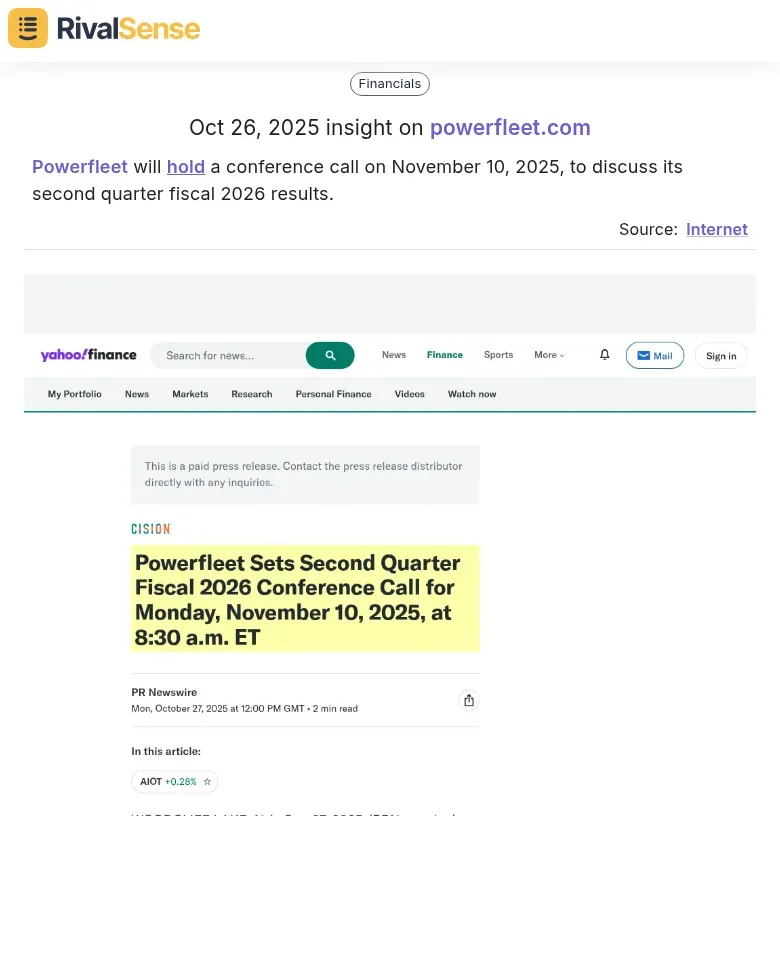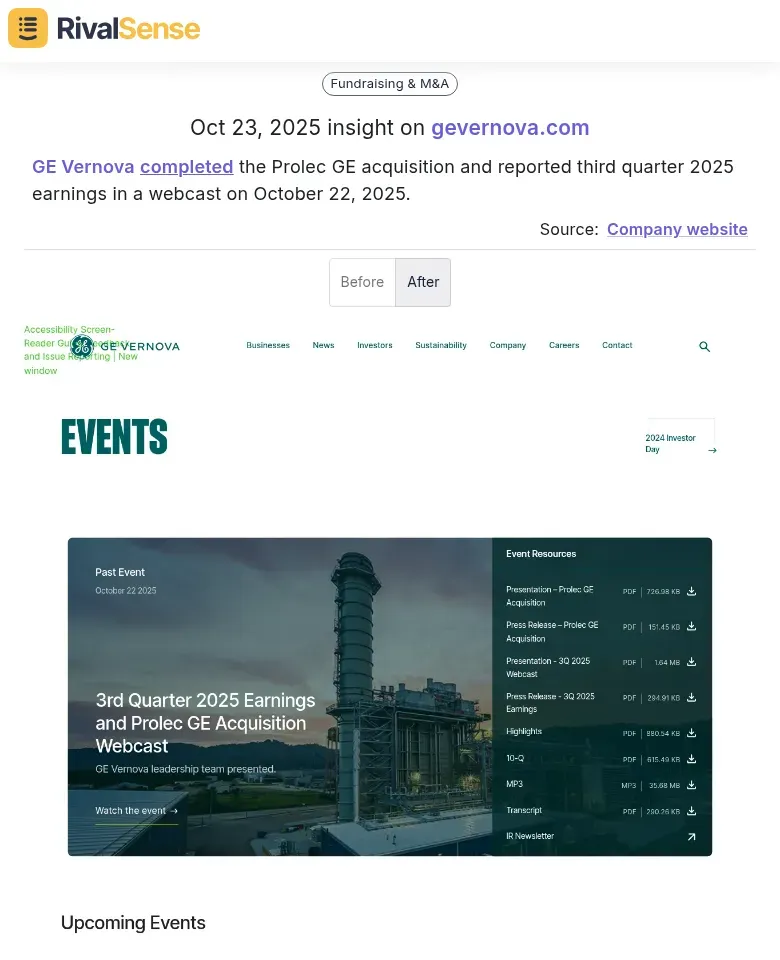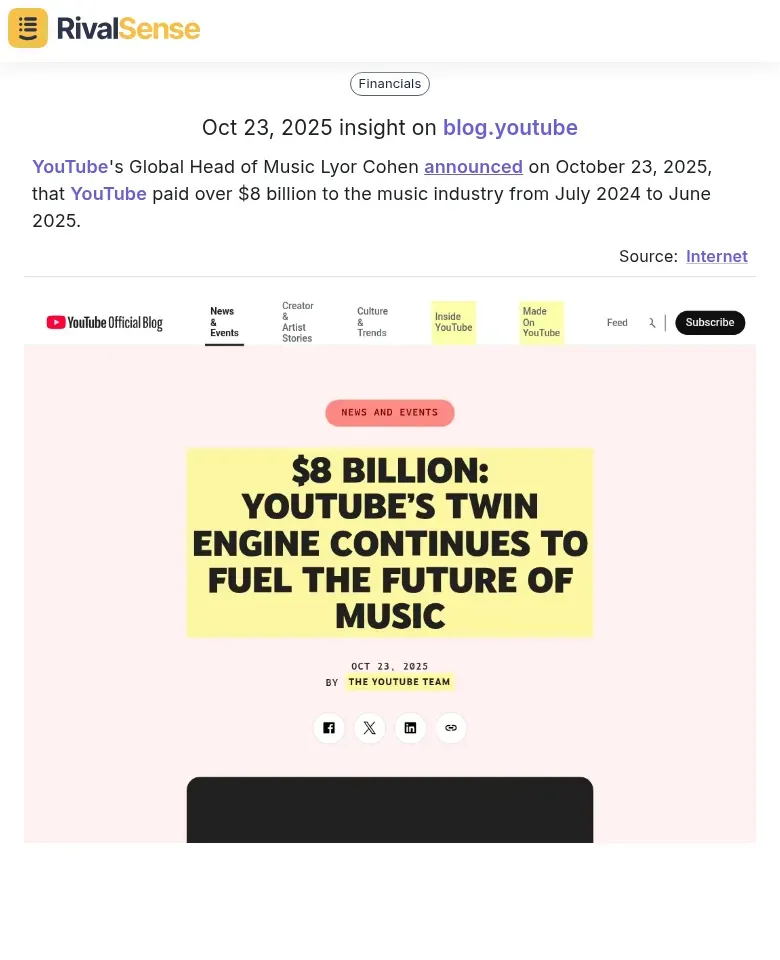Competitor Financials & M&A Cheat Sheet: Track Hiring for Insights
Understanding competitor financials and M&A activity isn't just about numbers—it's about decoding market intelligence. When competitors report strong financial performance, they're signaling market validation and potential expansion. Conversely, financial struggles often precede strategic shifts or market exits. M&A activity reveals consolidation trends, market gaps being filled, and emerging competitive threats. But the most forward-looking indicator? Hiring patterns. When competitors ramp up recruitment in specific departments—like AI, cybersecurity, or international sales—they're telegraphing their strategic priorities months before public announcements. Track these patterns: monitor job postings for new roles, analyze hiring volume by department, and watch for executive-level recruitment. These signals help you anticipate market moves, adjust your positioning, and identify talent opportunities. 💡 Practical tip: Set up alerts for competitor job boards and financial filings to stay ahead of strategic shifts.
Decoding Financial Announcements: What Earnings Calls Reveal
Earnings calls offer a goldmine of competitive intelligence when you analyze timing patterns. Most companies follow predictable quarterly cycles—typically 30-45 days after quarter-end—with calls scheduled strategically to maximize market attention. For instance, RivalSense tracked that Powerfleet will hold a conference call on November 10, 2025, to discuss its second quarter fiscal 2026 results.  This type of insight is valuable because it allows you to anticipate when competitors will disclose financial results and strategic updates, helping you align your own market responses and capital allocation decisions.
This type of insight is valuable because it allows you to anticipate when competitors will disclose financial results and strategic updates, helping you align your own market responses and capital allocation decisions.
Practical Steps for Analysis:
- Track Timing Patterns: Monitor when competitors schedule calls—early announcements often signal confidence, while delays may indicate issues
- Analyze Conference Call Scheduling: Note if calls cluster in specific time slots (pre-market vs. post-market) to understand their target audience strategy
- Map Financial Cycles: Use SEC filing deadlines (45 days for 10-Q, 60-90 days for 10-K) to anticipate when competitors will announce resource allocation decisions
Checklist for Strategic Insights:
- [ ] Monitor competitor investor relations calendars quarterly
- [ ] Note call timing relative to quarter-end and market hours
- [ ] Track changes in scheduling patterns over multiple quarters
- [ ] Correlate call timing with subsequent hiring announcements
- [ ] Compare your scheduling strategy against competitors'
Key Insight: Companies that consistently schedule calls during peak market attention periods typically have stronger growth narratives and more aggressive resource deployment plans. Use these patterns to anticipate when competitors will announce major initiatives or hiring surges.
M&A Intelligence: Reading Between the Acquisition Lines
Completed acquisition announcements reveal your competitors' strategic direction. For example, when a rival acquires an AI startup, it signals a push into automation. Track M&A timing to spot market consolidation trends—clusters of deals in a sector often precede industry shakeups. A recent example from RivalSense: GE Vernova completed the Prolec GE acquisition and reported third quarter 2025 earnings in a webcast on October 22, 2025.  This insight is valuable as it shows how M&A activities are often coupled with financial reporting, providing a comprehensive view of strategic moves, market positioning, and potential competitive threats.
This insight is valuable as it shows how M&A activities are often coupled with financial reporting, providing a comprehensive view of strategic moves, market positioning, and potential competitive threats.
Post-acquisition integration patterns expose competitive advantages; rapid team mergers suggest efficiency gains, while slow integrations may indicate cultural clashes.
Practical Steps:
- Monitor press releases and financial news for acquisition announcements
- Analyze deal rationales to understand strategic priorities
- Track hiring spikes in acquired companies' departments post-deal
- Note integration speed: fast = operational synergy, slow = capability absorption
- Use tools like RivalSense to automate tracking and get alerts on competitor moves
💡 Tip: Combine M&A data with hiring trends—if a competitor acquires a tech firm and then hires aggressively in that area, they're likely doubling down on that capability.
The Hiring Connection: How Recruitment Signals Business Strategy
Hiring patterns provide an early warning system for competitor strategy shifts. When a rival suddenly posts multiple roles for logistics coordinators in a new region, they're likely expanding geographically. A spike in AI engineer positions signals product development in that domain. Track these patterns systematically to decode their business strategy and anticipate market moves.
Practical Steps:
- Monitor job boards daily for competitor postings
- Create alerts for specific role types and locations
- Analyze required skills in job descriptions to understand capability gaps they're filling
- Note reporting lines mentioned - direct reports to new executives reveal strategic initiatives
Checklist for Analysis:
- [ ] Count new roles by department weekly
- [ ] Map geographic concentration changes
- [ ] Identify emerging skill requirements
- [ ] Correlate hiring spikes with public announcements
📈 Example: When a SaaS competitor hired 15 data scientists in Q3, they launched a new analytics product in Q4. The 3-month lead time gave us opportunity to prepare competitive positioning.
Focus on roles with strategic implications - senior hires, new department creation, or geographic expansion positions. These signal major investments before they're publicly disclosed.
Financial Metrics That Matter: Beyond the Headlines
Interpreting revenue distribution patterns and other financial metrics goes beyond the headlines to uncover deeper strategic insights. Payment integrations and strategic partnerships reveal ecosystem positioning and market influence, helping you benchmark against competitors. For example, RivalSense captured that YouTube's Global Head of Music Lyor Cohen announced on October 23, 2025, that YouTube paid over $8 billion to the music industry from July 2024 to June 2025.  This insight is valuable because it highlights significant financial transactions and partnerships, indicating the company's market reach, payment ecosystem strength, and potential areas for competitive analysis or collaboration.
This insight is valuable because it highlights significant financial transactions and partnerships, indicating the company's market reach, payment ecosystem strength, and potential areas for competitive analysis or collaboration.
Interpreting Revenue Distribution Patterns
Look beyond total revenue to analyze distribution across products, regions, and customer segments. A competitor with 70% revenue from one product line signals market dominance but also vulnerability. Track quarterly shifts: if their enterprise segment grows while SMB declines, they're likely targeting higher-value customers. 💡 Practical tip: Calculate revenue concentration ratios—anything above 60% in one segment indicates strategic focus areas.
Analyzing Payment & Partnership Announcements
Payment integrations and strategic partnerships reveal ecosystem positioning. When competitors announce Stripe or PayPal integrations, they're expanding payment options to capture broader markets. Partnership announcements with Salesforce or HubSpot indicate enterprise positioning. Checklist: Monitor press releases for (1) payment processor integrations, (2) technology partnerships, and (3) channel distribution agreements.
Financial Disclosures Benchmarking
Use SEC filings and annual reports to benchmark against industry standards. Compare gross margins, customer acquisition costs, and R&D spending ratios. If competitors maintain 40%+ gross margins while industry average is 30%, they likely have pricing power or operational efficiencies. 🚀 Actionable step: Create a quarterly dashboard tracking 5 key financial ratios against 3-5 main competitors to identify performance gaps and strategic opportunities.
Actionable Intelligence: Turning Insights into Strategy
Transform competitor financial and M&A data into actionable strategy with these practical steps to stay ahead in the market. By systematically analyzing insights, you can develop proactive responses and optimize your business decisions for competitive advantage.
Early Warning Systems: Monitor competitor announcement patterns—sudden hiring spikes often precede major initiatives. Set up alerts for executive hires, funding rounds, and expansion announcements. Track 3-6 months of hiring data to identify trends before public announcements.
Competitive Response Frameworks: When competitors acquire companies, analyze the target's technology, talent, and market position. Create pre-planned responses: if they acquire AI expertise, accelerate your own AI roadmap. Maintain a playbook for common M&A scenarios with 30-60-90 day action plans.
Hiring Strategy Countermeasures: Use competitor recruitment data to identify skill gaps and emerging priorities. If they're hiring data scientists aggressively, consider upskilling existing teams or adjusting compensation bands. Implement quarterly talent mapping to anticipate their next moves.
Checklist:
- [ ] Set up automated alerts for key competitor job postings
- [ ] Maintain a database of competitor acquisitions and their strategic rationale
- [ ] Conduct quarterly talent gap analysis vs. competitors
- [ ] Develop scenario-based response plans for common M&A patterns
- [ ] Track competitor executive team changes as leading indicators
Ready to leverage these strategies? Try RivalSense for free at https://rivalsense.co/ to get your first competitor report today and transform market intelligence into actionable business wins!
📚 Read more
👉 Leveraging Personnel Changes for Competitive Insights
👉 Competitor Market Research Reports: 5 Steps to Effective Analysis
👉 Competitor Partnership Framework: SaaS Growth Templates
👉 How JAL's Museum Expansion Uncovered Competitor Growth Strategies
👉 Instagram Competitor Insights: Data-Driven Key Account Growth
